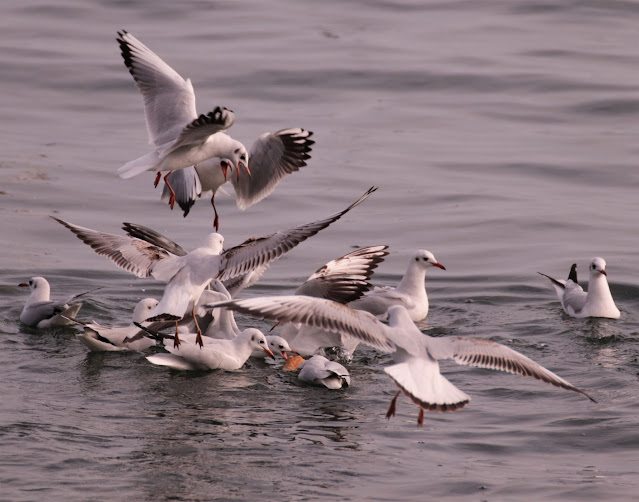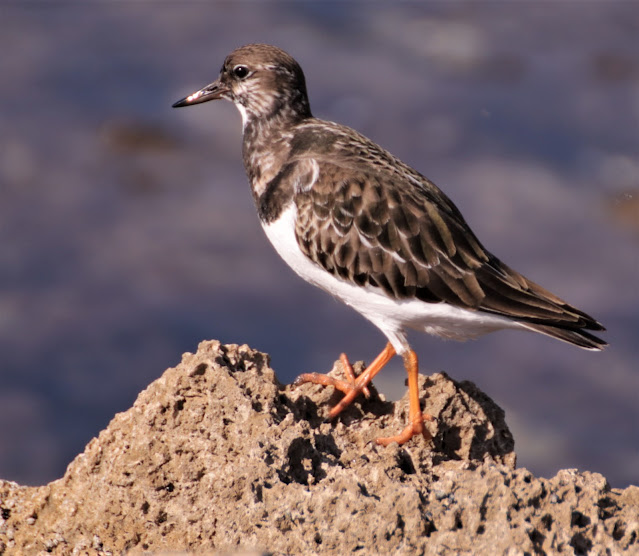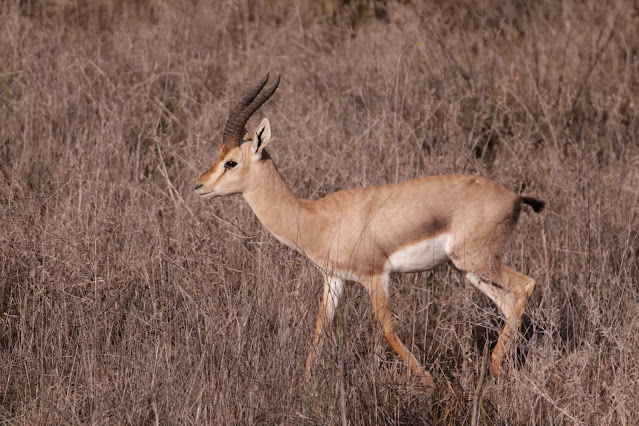This is a golden jackal (in Hebrew, tan), that I saw in urban parkland in Tel
Aviv last week. Jackals are generally nocturnal, but this was the day of the
jackal. The golden jackal is related to the wolf, which we also see in Israel.
It is quite wolf-like in appearance and not dissimilar in appearance to the fox.
Laurence S pointed out to me, that quite remarkably, in the film, the Jackal
was played by Edward Fox.
P.S.
The third of these pictures is now on Wikipedia - https://en.wikipedia.org/wiki/Golden_jackal- in the Description section.
---
In Israel
we see several different types of herons including the grey heron, the purple
heron, the squacco heron and the night heron. These pictures are of a night
heron at the Kinneret in Tiberias – it’s a medium-sized heron and its short
legs and neck, and stout body make it clearly distinguishable from the grey
heron and the purple heron. It’s called a night heron because it is
particularly active in the evening, but I photographed this nightbird early in
the morning, presumably after an all-nighter.
---
In a short
one hour visit to the beautiful botanical gardens in Kibbutz Ein Gedi, we saw
this magnificent ibex and these five birds.
The ibex is
a Nubian ibex (in Hebrew Yael) with an estimated total world population of just
over 1,000. In Israel, we find them in desert regions but this handsome fellow had
wandered into the kibbutz where it was feasting on the trees and shrubs.
The birds are:
1) Sunbird - a brightly coloured tiny
little bird – the male is an electric blue colour, as you see, and the female a
dull brown.
2) Tristram’s
grackle – a sort of
starling with orange tale flashes.
3) Hoopoe – Israel’s national bird.
4) Spur-winged
plover – plover rhymes
with lover – it has spurs on its wings for fighting off predators.
5) White-spectacled
bulbul – named so,
for obvious reasons.
Well worth a
visit!
---
Just a year
after our last visit, this week we visited the lowest point on earth, the Dead
Sea more than 400m below sea level, and Ein Gedi. The first and second pictures
are of a Syrian rock hyrax, a curious little animal whose nearest relation in
the animal kingdom is the elephant. In the second picture it’s trying hard to
look fierce. Then there’s a picture of a blackstart – this seems to me to be a
bit of a misnomer as it ends in black rather than starts in black. Then there’s
a white-crowned black wheatear, which is largely as described on the tin. The next
picture is of the David Waterfall in the Ein Gedi Reserve – we made the hike to
it, which we thought quite hard, though it said in the blurb that it was an
easy walk – we must be getting older. And finally comes the Dead Sea, with its
salt beaches.
After the
last photo is a link to a Youtube slide show that I put together after last
year’s visit with a musical accompaniment orchestrated by my very talented wife,
Miriam. It takes two minutes but it’s worth spending two minutes to listen to
her composition.
When I lived in England, to see a blue flash
as a kingfisher flew by was a once in a blue moon occasion. Here in Israel, we
see three different kinds of kingfishers - the common kingfisher (as I would very
occasionally see in England), its larger 'cousin' the white-throated
kingfisher, and the pied kingfisher. The common kingfisher is as majestic as
its name implies; it has a vivid blue back and head and pinky-orange breast and
is clearly distinguishable from all other birds. It’s a small bird, barely
bigger than a sparrow, and since each day it needs to eat about sixty percent
of its body weight, it’s constantly on the lookout for a nice fish or crab for breakfast,
lunch and supper. The white-throated kingfisher unsurprisingly has a white
throat, and it has a brown front with blue back. It’s more than one and a half
times the length of the common kingfisher, which makes photographing it a wee
bit easier. The pied kingfisher, similar in size to the white-throated
kingfisher is clearly identified with its distinctive black and white plumage.
It can often be seen hovering twenty feet or more above the water surface
waiting to dive on its prey.
These photos were taken this week in Tel Aviv and are the common kingfisher. In future posts we’ll look at the white-throated kingfisher and the pied kingfisher.
Yesterday’s
photos were of black-headed gulls with white heads in their winter plumage. These
gulls are winter visitors to Israel, so here is a photo of a black-headed gull
that I photographed during my summer visit to England – this was at Golden Acre
Park in Leeds. You can see it’s not really a black head but is chocolate brown,
so black-headed gull is a bit of a misnomer.
Black-headed
gulls
These
photographs are of white-headed black-headed gulls. In the summer the gull’s
head is black (well actually chocolate-brown) but these birds are showing their
winter plumage.
A gull
flying over the lake spots a discarded bun in the lake. Fish in the lake were
feeding from it and the gull descended to feed from it too. Some of the gull's friends and colleagues decided to join in and a bun fight soon ensued.
Photographed
at the Kineret in Tiberias a few days ago.
---
February is
the peak time for seeing wild cyclamens in Israel, but cyclamen season has already
started. I photographed these flowers this week at the peak of Mount Arbel –
mid December at 23 degrees (I don’t mean Fahrenheit).
13th December 2022
Israel has
a large population of parakeets, following the release or escape of pets into
the wild. Parakeets are native to Australia and are small to medium-sized parrots.
These photos are of a Rose-ringed parakeet and two Monk parakeets, the two
types of parakeets found in Israel. Judging by the loud squawking, these monks
hadn’t taken a vow of silence.
---
11th December 2022
On two
recent trips to Ramat HaNadiv (one last week, and the other a couple of weeks
ago) I photographed these two fellows in a lily pond. But are they frogs or are
they toads, both of which are found in Israel? Toads are from the frog family -
all toads are frogs, but not all frogs are toads. Generally speaking, frogs are
aquatic creatures with moist skins and long legs while toads are terrestrial
creatures with warty dry skins and shorter legs. These two fellows are actually
marsh frogs.
---
8th December 2022
“A funny old bird is a pelican. His beak
can hold more than his belican. Food for a week, he can hold in his beak,
but I don’t know how the helican.” Dixon Lanier Merritt
Funny old bird is the pelican. It dips its head in the water. Fills its enormous
beak with water and fish. Then lifts its head up, opens its beak wide so that
the water drains out and the pelican then feasts on the fish it caught. Oh, and
by the way, its beak can hold three gallons (eleven liters) of water, which is
three times as much as the capacity of its stomach. So, it’s certainly true –
its beak can hold more than its belly can!
Pelican migration takes place during spring and autumn
(March to April, and October to November). Most years forty thousand or so
pelicans fly over Israel, looking for shelter and food. They’re particularly
fond of fish so are attracted to Israel’s lakes.
In the autumn they travel from Europe to Africa where the
winter climate is somewhat warmer than in Europe and in spring they travel in
the opposite direction. They prefer to travel over land rather than over the
sea – it’s safer for them - so
Israel is on the flight path. And, of course, not being a kosher bird, it’s
perfectly safe for the pelicans in Israel.
If you have a minute and a half, you might like to look at this slideshow I put together last month of pelicans that I photographed recently – best viewed with your phone turned sideways (landscape).
---
7th December 2022
One of the
great things about living in Israel is I get to see exotic birds and animals.
By exotic, I mean those that I wouldn’t have seen in England without going to
the zoo. As a child, living in Leeds, a favourite treat was a trip to Flamingo
Park Zoo near Pickering (now renamed as Flamingo Land) where there was a colony
of flamingos. There are flamingos at Tel Dor at the moment – no trip to a zoo
required - and these flamingos can fly, which I’m sure wasn’t the case for those
in the zoo. Aside from looking somewhat unusual and certainly exotic, flamingos
have a particularly unusual characteristic. As we all know mammals produce milk
to feed their young and birds don’t. But flamingos do. They produce milk in
their crop and feed it to their young. They are not alone in the bird world in
having this ability – pigeons do as well, and so do emperor penguins. These
photographs are from a visit to Tel Dor this week and a visit two weeks ago.
On Sunday
we visited Chof Dor Habonim, which, in my opinion is one of the most beautiful
parts of our Mediterranean coastline. I saw this rather handsome bird who was
there on the rocks with a few friends. It’s a Ruddy Turnstone (in non-breeding
plumage) - a nine-inch wader, primarily a winter visitor to Israel. As its name
suggests, it leaves no stone unturned in its quest for a good meal.
5th December 2022
These photos
are all cattle with cattle egrets. The black cow feeding its calf is a water
buffalo in the Hula Valley. More about water buffalo on a future occasion. The
other photos were taken in the Switzerland Forest, next to Tiberias.
---
4th December 2022
Cattle Egret
landing
I
recently photographed this sequence of pictures of a Cattle Egret landing at
Agamon Poleg near Netanya. We see them close to home too. One of our favourite
haunts is the Switzerland Forest in the hills and mountains overlooking much of
the Southwest coast of the lake – and there a herd of cattle attracts Cattle Egrets.
A small white bird in the heron family, it spends much of its life stalking
cattle. It feeds on insects particularly grasshoppers and crickets as well as
lizards and even small fish. I’m always delighted to see them as they forage
amongst the cattle, where their chance of a good meal significantly increases.
I’m often rewarded with a glimpse of the egret walking or riding on the back of
a cow which seems completely oblivious to its passenger. Of course, it is
providing a good service to its host or hostess helping to rid it of fleas and
other pests – a win-win scenario, though not so good for the fleas.
Tomorrow,
I hope to post photos of Cattle Egrets with cattle.
---
2nd December 2022
The
first of these pictures is a Praying Mantis. I photographed it last year in March
at Nachal Tzipori in the Galil region. It gets the name Praying Mantis because it
stands with its long legs together as if in prayer. In Hebrew it has an interesting
name too, גמל שלמה – Solomon’s Camel. It was assigned this name as
there is a story that King Solomon was so angered by his camel that he turned
it into an insect.
I
photographed the second of the pictures yesterday at the Switzerland Forest near
Tiberias – this shell-like structure is about 1.5 inches from top to bottom (also
from bottom to top) and was attached to a wooden signpost. It took a little
research (via Google of course) to establish that this is the egg sac of a
Praying Mantis and stores about 300 or so eggs until they hatch.
The
third photo is a misty autumn morning in the Switzerland Forest.
[PS - yesterday’s picture was a bulbul. My friend Salome tells me that In Persian and Turkish, bulbul means nightingale. Though the bulbul is a songbird, I don't think it's closely related to the nightingale.]
We visited
Gamla yesterday hoping to see the vultures, but there weren’t any around. We
saw bulbuls instead. One presumes that the bulbuls saw off the vultures!! This
handsome bird is the white-spectacled bulbul (בולבול צהוב שת) which did very well in the election for Israel’s National Bird
but ultimately lost out to the hoopoe. Strange word is the bulbul - the Collins
English Dictionary says that the origin of the word is via Persian from Arabic.
29th November 2022
These
birds are guineafowl (probably worth just £1.05 each) – they’re rather
curious-looking – almost ball-shaped. We were walking near Agamon Poleg (near
Netanya) and encountered a small flock of 15 or so guineafowl. Guineafowl are
found in the wild and are also farmed – but it wasn’t clear to us whether these
were wild or not.
The big
question is – are they kosher? There is some debate. The OU writes, on its
website - “The research into the identification of kosher birds is not yet
complete. There are other birds which are not certified as kosher, but there is
evidence that they were accepted as kosher by some Jewish communities at some
point in time. Among the birds currently being researched by the Orthodox Union
are species of pheasant, partridge, peacock and guineafowl (also known as the
African chicken). In all of these instances, rabbis in Israel and America are
searching for people to conclusively identify the birds which were consumed in
the recent past and accepted as kosher by the rabbinic authorities.”
So, for the time-being, we’ll stick to chicken, turkey and duck. And this being so, perhaps it’s more likely that it was a wild flock we saw.
---
28th November 2022
Gazelles at Jerusalem's Gazelle Valley. A male, a female and a galloping male. It seems that on cold days the gazelles run fast to keep warm. Gazelle Valley is an urban nature reserve - in the heart of Jerusalem and has a herd of 50 or so gazelles. We're used to translating tzvi as deer (as does Artscroll and the Chabad website), but actually the tzvi is a gazelle (translated correctly by Sefaria). It seems that European Torah translators and commentators chose deer, as deer are found in Europe. They weren’t aware of gazelles which are not found in Europe.

.JPG)
.JPG)
.JPG)
.JPG)
.JPG)
.JPG)
.JPG)
.JPG)
.JPG)
.JPG)
.JPG)






























.jpg)
.jpg)
.jpg)
.jpg)
.JPG)
.JPG)
.JPG)
.JPG)
.jpg)

.jpg)







-2.jpg)

No comments:
Post a Comment
Note: Only a member of this blog may post a comment.